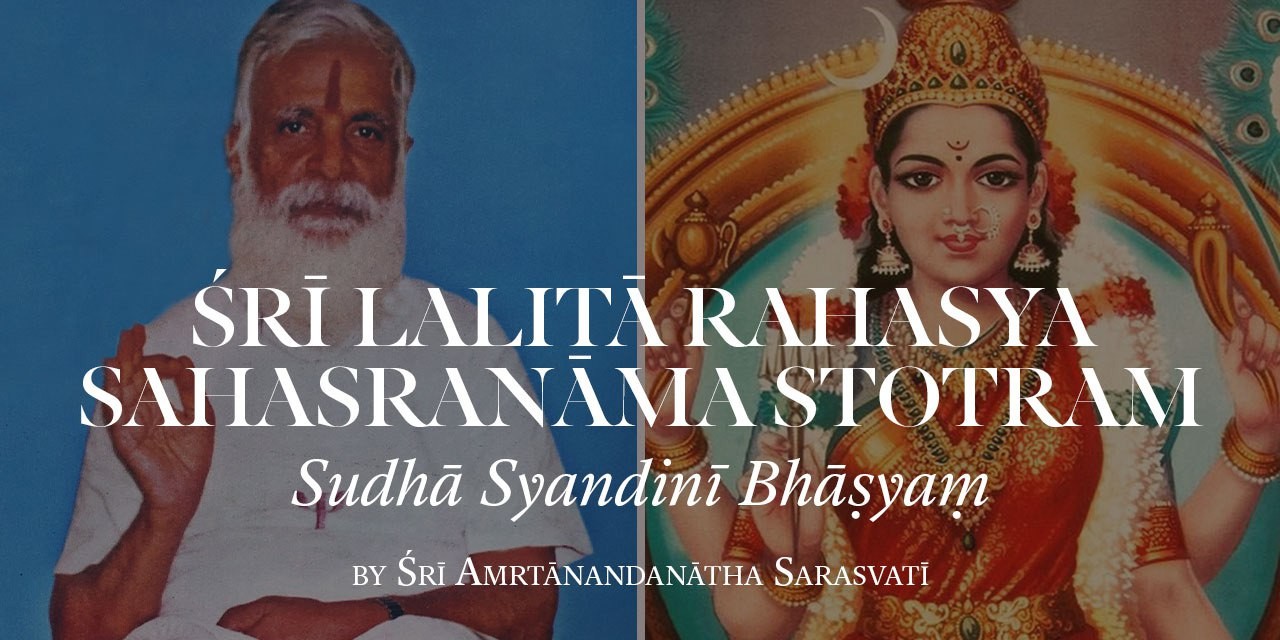- Edited

21) Kadambamañjarī-kḷpta-karṇapūra-manoharā
Lalitā's ears are surrounded by flower garlands; She is bewitchingly beautiful to look at. The word manohara can also mean, taking the mind away. Utter beauty always has this effect on the mind; mind ceases to function, and stares at the object in silent wonder.
Sādhana
The ear is an instrument of the mind for perceiving sound. The flowers around the ears signify beautiful sound forms, music full of melody and harmony; if used for contemplation, and for worship, the mind gets totally absorbed in the happiness. Upaniṣads say of Brahman; “Raso vai saḥ”, meaning, indeed Brahman is a merger into happiness. Tyāgarāja, Muthuswamy Dīkṣitar, Śyāmā Śastry are a few of the examples of musician saints who achieved Godhead through music in worship. Tyāgarāja says: “Saṅgīta jñānamu bhakti vinā; sanmārgamu galade manasā”. Meaning, without devotion is there any other proper way for music? Even earthly love gets transformed into divinely glorious forms when it addresses itself towards God. The love we mortals are capable of is very minute indeed. Only God can have infinite love and its expressions as visions, music, dance and ecstasy. There are many saints in the Vaiṣṇava tradition who deny themselves the total merger of the Śaiva and Śakti cults and prefer to pine for the divine loves, so great is the love power of God! The torrents of love expressed to Kṛṣṇa unleashed by the epic stories of Mahābhārata and Caitanya Mahārabhu flow even today as witnessed by the Kṛṣṇa consciousness movement. Lalitā is the female form of Viṣṇu Māyā, the Jaganmohinī, the consort of Sadāśiva. Soul stirring music expressing the love of the devotees to God are the proper means to reach up to God, to merge ecstatically into the divine love. The path of the ear is the path of love, devotion to God which admits of no logic. There is an illogical logic of its own belonging to bhakti. To the followers of the path of knowledge, this may appear like self made slavery until they have tasted the sweetness of God. Once any person has tasted the bliss of God, there is no going back. What happens when music gets ecstatic? Tears roll down the eyes, heart melts away; your very life depends on the continuation of the solo violin hanging on the edge of a precipice. And you die when the music dies. Are you really dead? Is the solo violin hanging on the edge of a precipice? Did your heart really melt away? Why are you crying if you are happy? These ecstatic states defy reasoning and logic, they admit of opposites into emptiness also. The is fullness and there is emptiness also.
The sound in meditation merges into the mind, mind merges later on into divine forms or visions. In its most elemental form, mind is full of seeds which can grow into thought forms, so it is considered in ancient India to be like semen, and the word bindu covered both the mind and the drop of semen. The concentration on the sound, called nāda, leads to an orgasmically blissful state where the bindu drops off – in the ensuing peace and relaxation lies the vision of God as the one who has no desires because all desires are fulfilled in it. Every music is very much like intercourse; in the prelude, in the build up of tempo, in the mounting tension, the unbearable climax, the final release from the tension, the encore, the effects are identical. Little wonder then, that music expresses the passionate love for God so well, and is the most direct means to reach the Divine Heart. This is why there is such an attraction for bhajan gatherings, as they come closest to an orgasmic release of frustrations into the love of godliness. Music is a socially accepted form of a group reaching a climax together!
This contemplation of sound has given birth to the entire mantra śastra, and of the magical powers associated with the chanting of these mantras. The power of Kuṇḍalinī expresses itself as a supremely blissful sexual ecstasy in the initial stages, later on it finds expression as music, dance and art forms, then as revelation of godly visions, of expression of divine powers and finally merger into Godhead. Much more will be said later on about the Kuṇḍalinī yoga at the appropriate places. This upāsana of the sound form, especially as music, is called the nāda bindu kalā. Kalā refers to visions of the divine, in its manifest forms.
Source: Śrī Amṛtānandanātha Saraswatī "Sudhā Syandinī Bhāṣyaṃ" Typed Manuscript
(an incomplete commentary on Lalitā Sahasranāma)

